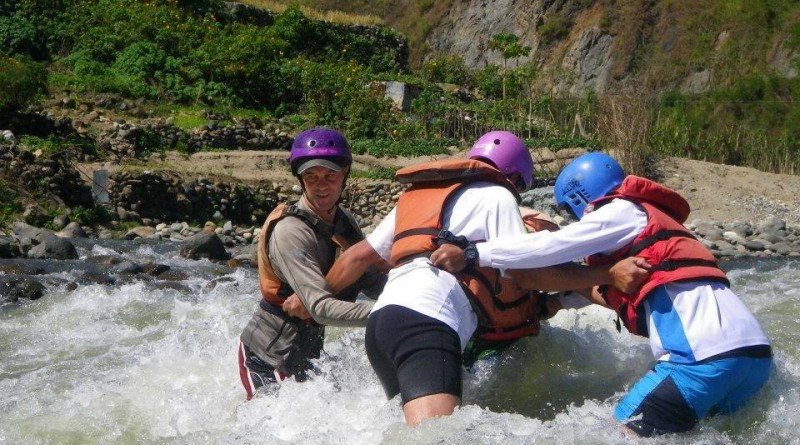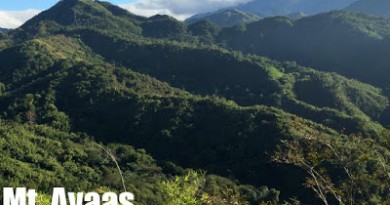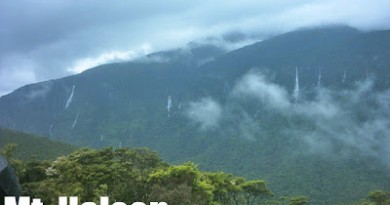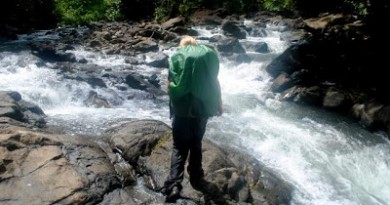River Crossing Accidents: Why They Happen and How They Can Be Prevented
by Steve Rogers
Last month’s tragic drowning of five hikers in San Jose, Tarlac is a wake-up call for the mountaineering community to raise awareness of river safety in the Philippines. In this article, longtime outdoorsman and rafting instructor Steve Rogers, who has lived in the Philippines for several decades, talks about and makes a case for the importance of swiftwater training.
River crossings have emerged as the leading cause of fatal accidents in the Philippine hiking/mountaineering community. Consider the record:
– June 2008: 3 hikers drowned attempting to cross a river in Pundaquit, Zambales
– August 2009: 2 hikers drowned attempting to cross the same river in Pundaquit, Zambales
– September 2011: One hiker drowned trying to cross the Wawa River in Montalban during a training exercise
– August 2014: 7 Bulacan State University students drowned in a flash flood while attempting a crossing of the Madlum River.
– August 2015: 5 hikers drowned in a flash flood while attempting a river crossing during a hike in San Jose, Tarlac
Perhaps not all of those who died were “mountaineers”. They may not have passed a BMC or been members of an established outdoor organization. Still, they were engaged in hiking as outdoor recreation, and (in my opinion only) the frequency and death toll of river crossing accidents requires an organized response from the outdoor recreation community. One life lost in the pursuit of outdoor recreation is one too many. 17 young people dead in 7 years in river crossings alone is simply unacceptable. We cannot change the climate or geography of the Philippines. Our mountains often receive abrupt extremely intense rainfall. Many of our watersheds are degraded and prone to rapid runoff. Flash floods will happen. The behavior of water won’t change, but the behavior of people can. Awareness can be upgraded, risk assessment and decision making can be improved, new techniques and standards can be adopted and taught. It will take time and effort, and even with maximum effort there is no assurance that every incident can be prevented… but doing nothing is little more than an assurance of more deaths.
My proposal derives from a position straddling multiple outdoor communities. I grew up in the mountains and have been hiking the Philippine mountains since the 1980s. I’ve also been involved in white water kayaking and rafting for several decades, a process that has led to involvement in swiftwater rescue training for both river guides and first responders. My suggestion is simply that the skills and knowledge of the river recreation and swiftwater rescue communities can be transferred to improve river crossing safety practices in the trekking/mountaineering community.
Modern swiftwater rescue involves an extensive body of knowledge and practice developed in a collaborative effort between the whitewater recreation community and the first responder community. Much of what river guides and rescuers study and practice is not relevant to mountaineers, but there are many elements of swiftwater rescue, most notably river mobility, river crossing, and site evaluation and preparation methods, that are directly applicable and could significantly upgrade safety practices in the hiking/mountaineering community.
How to communicate and spread this body of knowledge is a more difficult question. One proposal begins with reassessing and upgrading the river crossing component of the Basic Mountaineering Course (BMC). That of course is not enough, as many of the groups in the field today do not contain a single person who has taken a BMC, but the BMC remains the primary vehicle for disseminating knowledge in the trekking/mountaineering community and this remains a viable starting point. Other options include making training available to groups and trip leaders, and simply spreading awareness that better practices exist.
What Goes Wrong… and How to Change It
Reviewing the incidents listed above reveals obvious common factors. One incident occurred in late June, three in August, one in September: all during rainy season. Most incidents occurred late in the day, when probability of rain in upland areas is highest, and when tired groups eager to get back to shelter are vulnerable to poor decision making. All of the events occurred within a day’s trip of Manila, on relatively easy routes that attract large groups of less experienced hikers. Three incidents involved voluntary entry into already hazardous waters (two in an effort to get home, one in a training exercise), two involved the unanticipated hazard of flash floods occurring during a large-group river crossing.
The first step toward preventing accidents – and the first part of any swiftwater-related training – is developing a better understanding of what moving water is, how it behaves, what factors influence it, and how to predict its behavior. Despite its apparent chaos, moving water is in fact highly predictable, and understanding that is the first key toward reducing accidents. A half day in the classroom, supported by subsequent in-water exercise, is sufficient to communicate the essential concepts.
Before any swiftwater training addresses technique, attention has to be paid to decision making, and to the most important (and in some cases irrevocable) decision you can make in a swiftwater situation: to enter the water or not to enter the water. The first and best advice in a high water river crossing situation is simply “when in doubt, wait it out”. Water that rises fast will typically fall just as fast. You may be cold, you may be wet, it may be getting dark, and that river may be the only thing between you and comfort… but you can live over a week without food, under a minute without oxygen. If a river is visibly flooded, discolored, with floating debris, if the depth is not possible to determine, if you have any doubt at all over whether the group has the expertise, strength, and equipment needed for a safe crossing… retreat to higher ground and wait. Do not attempt foot crossing of fast moving water that is above crotch-deep on the shortest member of the group, even using the cluster crossing techniques taught in swiftwater rescue classes. If a crossing is already in progress and the water turns out to be deeper or more powerful than expected, retreat and reconsider. Risk assessment at this stage includes both immediate risk – hazards actually present in the conditions observed – and potential risk of rapidly changing conditions, based on season, time of day, observed weather conditions, and river geography. Situational awareness is critical: a summer day with horizon-to-horizon clear skies presents a very different hazard set from a rainy season afternoon with nearby mountains covered in dark cloud. Selecting a site for a river crossing requires experience and training, and should not be done casually or on the assumption that “where everybody does it” is ideal or appropriate.
Once You Decide to Cross…
An actual river crossing is not simply a matter of walking across a river, particularly with a large group, a group with less capable or experienced members, or when actual hazards like strong current and/or deep water are present or when the season, time of day, weather or other factors indicate elevated flash food risk. An unmanaged crossing typically devolves into a string of hikers spread out across a river, with no system in place for early warning of hazards, no capacity for downstream rescue, no overall control or decision making capacity, and no plan. As a result, if emergency strikes there is little warning, and inexperienced individuals have to respond on their own, often leading to panic, paralysis, and tragedy.
Trained swiftwater operators approach any swiftwater event, even a simple river crossing, with a sequence of actions. An overall controller is appointed, typically the most experienced member of the group. The controller devises a plan, usually working with other senior group members. Before anyone actually approaches the water, a spotter is placed upstream with a signaling device (usually a whistle) to warn of floating debris, water level changes, or other hazards. If flash flood risk is judged to be high, a judicious controller might elect to place multiple upstream spotters to give the earliest possible warning, using one spotter at maximum signallable distance upstream from the group, and another farther upstream to relay a warning. Downstream safety is set, using positioned rescuers with throwbags: anyone regularly performing river crossings should invest in a throwbag and in the training needed to use it effectively.
Upstream spotters are instructed to look out for any sign of a surge: sudden discoloration of the water, an unusual wave pattern, an increase in level, even a sudden wind or sound from upstream. Any suspicion of a possible surge, no matter how tentative, must result in an alert and immediate clearance of the crossing. If it turns out that there is no surge, so be it: this is one situation where safe is infinitely better than sorry!
Once the safety measures are in place, the crossing begins… in small clusters of 4 to 5 hikers, with at least one experienced hiker in each group, even if that means some experienced group members must make multiple crossings. This strategy avoids a situation where individuals are strung out without support, and assures that at least one individual capable of rapid decision making is present in each group. Timing of groups is determined by the incident controller, but typically a second group will not move until the first group is past the crossing midpoint. The first group to cross places downstream safety and upstream spotters on their side of the river, allowing the upstream spotters on the origin side to return to the crossing site. Downstream safety on both sides of the river should be maintained until the final group crosses. When all group members have crossed the controller calls in the downstream safety and completes the crossing.
Complicated? A bit, yes… but with practice these systems become reflex and can be implemented with minimal time and effort. More important, they produce the highest possible probability of a safe crossing, and that’s the goal of the exercise.
Better Ways
Note: a few specific techniques are described here to give an idea of what is possible. They should not be attempted in the field without training and practice. Where moving water is concerned, everything is more complicated than it sounds, and the consequences of error may be immediate and severe.
Smaller groups of more experienced mountaineers may be able to adapt other techniques used in swiftwater rescue. Small groups looking for a more stable way to cross relatively shallow fast water (again, below crotch deep on the shortest group member) can use what we call a turtle: a group, typically of 4, supporting each other during a crossing. In a turtle formation one person moves at a time, with the others providing solid support for the moving individual. The turtle requires constant communication among group members, and is as slow as its namesake, but provides a relatively small group with effective support during a crossing. Again, upstream spotters and downstream safety should be in place.
One of the most frequent and dangerous mistakes hikers make is the misuse of rope. A rope, properly employed, can be a vital tool, and at times a lifesaver. Used wrong, a rope can be deadly, and can provide a dangerous and false sense of security, encouraging people to enter dangerous situations by convincing them that the rope makes them safe.
The first rule of using rope in fast water is that nobody should ever be tied to a rope, the sole exception being the use of a purpose-built rescue PFD with an integrated breakaway harness enabling the user to release from the rope at will. There are few faster or more reliable ways to die in swift water than to be tied to something: the typical end result is the tied individual being spun, thrashed, and forced down by moving water, with drowning resulting in short order.
Another common error in rope-assisted river crossings is to tie a rope directly across a river and attempt to use it for support in a foot crossing, sometimes even referring to it as a “lifeline”. This is a dangerous and inappropriate tactic that should not be used. No matter how tight the rope is tied, it will always sag downstream under pressure, forcing the hikers using it as support to work upstream, fighting the current, on the second half of their crossing. A hiker that loses footing while holding a rope in swift water will pivot downstream around the axis of the rope, ending up in a “superman” position, unable to force their legs back to the bottom against the current. Eventually – usually quite quickly – they will let go.
If you are planning a rope-assisted river crossing, remember a basic principle: do not fight the water. If your plan or strategy relies on people fighting against current, it’s a bad plan and it will probably fail, potentially catastrophically. When people fight water, people lose. The goal is to understand what the water is doing, work with it, and use its power to help you.
In most cases, if water is deep enough or fast enough to require a rope, individuals making the crossing should not touch the bottom of the river. Putting feet down in fast water has inherent risks: the bottom is where the rocks, snags, and other obstacles are, they often cannot be seen and they can damage and entrap feet and legs.
There are multiple ways to achieve this, all of which require training and practice, and typically at least one person with enough swiftwater swimming skill (a quite different discipline from flatwater swimming, and one that requires training and practice) to get to the other side of the river. If that can’t be done safely, the crossing has to be aborted or a different method used.
One effective rope assisted crossing technique is the pendulum. To use this method upstream spotters and downstream safety are placed, after which the strongest swimmer in the group gains access to the other side of the river. The actual crossing location should have relatively even current, no rocks or other obstacles, and areas suitable for entering and leaving the water. The swimmer on the far side tosses a throwbag across, and from an upstream position belays the successive swimmers across. The swimmers lie on their backs, feet downstream, with the rope over one shoulder, the shoulder closest to the bank they are leaving. In this position the force of the current will swing the swimmer across the river very quickly and much more safely than in a foot crossing. Again, the second person to cross sets downstream safety on the far side of the river, the third acts as upstream spotter, allowing the initial upstream spotter to return to the crossing area, and the downstream safety person on the near side crosses last, maintaining downstream safety on both sides of the river as long as possible.
Another effective method is the angled rope, in which a rope is suspended tightly (a z-drag may be used to achieve tension) across the river at a steep downstream angle, at least 45 degrees, just above the surface of the water. Once the rope is in place, which again requires one person to cross unassisted, each swimmer places a carabiner or pulley on the angled rope, with a short tail of rope or webbing attached. The swimmer holds the tail over the shoulder closer to the bank they are leaving. If the rig is correctly deployed, the force of the current will slide the swimmer down the angled rope and across the river to the designated receiving zone. Both of these methods allow backpacks to be sent across the river apart from their owners. In both of these techniques strong current is actually an advantage, as they rely on the force of the current to move the swimmer across.
Prevention is Best
In retrospect, each of the fatal incidents cited above was preventable. That comment is not meant to blame anyone, it’s simply a statement of fact, and a reason to change the way the Philippine outdoor community addresses river crossings. Both of the Zambales incidents would have been avoided if the individuals had decided to wait until the water receded, even if that meant spending a miserable night out in the rain. The Wawa incident could have been prevented by properly equipped downstream safety and proper rope assisted crossing technique. The victims in the flash food incidents in Bulacan and Tarlac would have had a far greater chance of surviving with upstream spotters and downstream safety and an effectively organized crossing plan in place.
Simple steps to save lives:
Hikes involving river crossings should be avoided during bad weather, or even rainy season. LGUs and guide groups may wish to consider closing potentially hazardous routes at some times. The trek will still be there in dry season.
The decision to cross a river must be critically evaluated with awareness of actual and potential hazards. When in doubt, wait it out.
Once a decision to cross is made, act systematically. Appoint a controller, develop a plan, set upstream and downstream safety, and execute the plan. Don’t be afraid to change the plan if conditions change or if the original assessment of conditions proves inaccurate (for example, if water turns out to be deeper or faster than originally believed).
Trip leaders and guides should plan ahead and bring the equipment they will need. Anyone who can afford a tent and backpack can afford a throwbag, a good whistle, even a z-drag kit and personal carabiners or pulleys.
Seek training in moving water operations, learn the appropriate skills, and practice them whenever possible.
Be open to new knowledge and new methods. Sometimes the biggest obstacle to knowledge upgrades can be experienced individuals who insist that they already know… I have personally experienced being rebuffed with “sino ka, kami ay mga instructor dito” when pointing out potentially dangerous errors in a river crossing setup.
The current obstacle, of course, is that no systematic training in these disciplines is currently available. The capacity exists: river guides in Mt Province and CDO can modify their own training regimes to serve hikers, and increasing numbers of rescue operators in Manila are developing a swiftwater capacity that again could be modified to serve the hiking/mountaineering community. If these organizations pool their knowledge and resources and develop a standard curriculum and training method, it would be possible to disseminate the needed skills in a systematic and effective way. It won’t happen overnight, and the sad truth is that even if the process starts tomorrow there are still likely to be needless deaths before it can take full effect. Again, though, doing nothing is just a guarantee that more people will die.
The proposal, then, is simple: the river community and responders with swiftwater rescue experience can join together and develop a training program designed to enhance river crossing safety for hikers and mountaineers. The mountaineering and hiking community can organize themselves to train and to disseminate these methods and skills be training more trainers. It will require cooperation, effort, and time… but if it saves even one life, wouldn’t it be worth it?








Leave a Reply
Be the First to Comment!